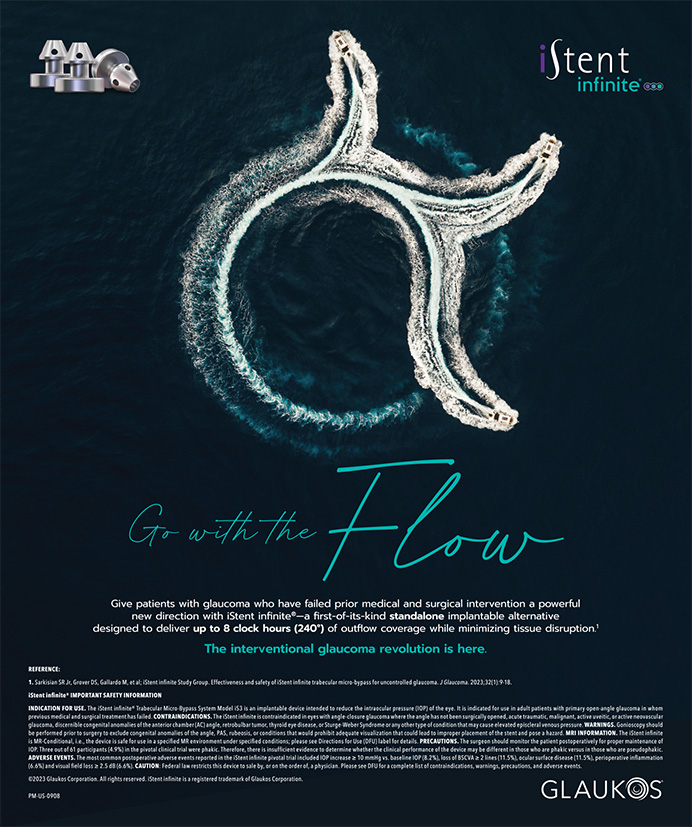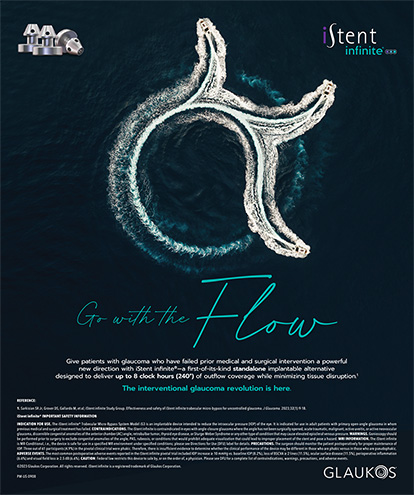As cataract and refractive lens exchange surgeons try to meet their patients' increasing expectations for rapid visual recovery, I find that an inclusive plan for pre-, intra-, and postoperative care minimizes complications and improves patient satisfaction.
PREOPERATIVELYLaying the Groundwork
With today's level of consumer education, patients enter my office expecting unaided functional visual acuity after their cataract surgery. I must step up to the plate and try to fulfill their desires. Consistent and comprehensive preoperative office processes lay the groundwork for a smooth procedure. Quality-control mechanisms, particularly with biometry, are very important. These disciplines help avoid operative problems and provide the best possible results without IOL miscalculations.
Managing ExpectationsThe most important key in delivering successful outcomes is communicating with patients and managing their expectations. Helping patients understand that there are no guarantees with any surgical procedure, especially with intraocular microsurgery, manages their expectations and emphasizes how they can help speed their postoperative visual recovery.
AnesthesiaPatients receive anesthesia in the holding area. My staff and I first employ IV sedation because, once we apply topical anesthesia, patients tend to keep their eyes open. Initial sedation encourages lid closure.
After we apply topical Tetracaine (Bausch & Lomb, Rochester, NY) and an antibiotic, we like to use a customized topical anesthesia called Xylocaine slurry. This mixture includes Xylocaine 2% jelly (Astrazeneca LP, Wilmington, DE), Mydriacyl 1% (Alcon Laboratories, Inc., Fort Worth, TX), Mydfrin 2.5% (Alcon Laboratories, Inc.), Zymar (Allergan, Inc., Irvine, CA), Acular 0.5% (Allergan, Inc.), Neo-Synephrine 10% (Bayer Corporation, West Haven, CT), and Xylocaine 4%. To mix the aforementioned ingredients, it is best to use a 10-mL syringe. We remove the plunger and add the Xylocaine 2% jelly. For every 1mL of Xylocaine jelly, I add 2gtts of each medication, with the exception of the Xylocaine 4%. I use 4gtts of the Xylocaine 4% to each 1mL. This concoction is a slurry rather than a true jelly mixture. The key is not to make the material toxic to the corneal epithelium. When the cornea keeps its integrity, vision recovers more quickly postoperatively.
Pupillary DilationWhen dilating the pupil, I choose Mydriacyl and not Cyclogyl (Alcon Laboratories, Inc.). Most practices use the latter because it dilates the pupil a little better. Because its effect is also harder to reverse, however, pupils tend to stay dilated longer. I like to see the pupil return to its physiologic state as soon as possible after surgery, and I therefore choose mydriatics that do not have as long a dilation effect.
In the ORAfter the patient enters the OR, my staff and I are diligent about keeping the cornea hydrated and avoiding corneal trauma. It is important to follow even simple steps to avoid contact with the corneal epithelium, such as using care when placing the drapes on the patient and especially when inserting the lid speculum (Figure 1). These steps can be especially difficult when using only topical anesthesia, because patients may try to close their eye around the speculum. Whoever places the lid speculum must be very gentle in pulling the lids away from the corneal surface.
INTRAOPERATIVELYAstigmatic Treatment
For eyes that require astigmatic reduction, I use limbal relaxing incisions at the beginning of the case, when the cornea is still moist. I then make a clear corneal phaco incision and a sideport incision.
Enlarging Miotic Pupils
For stubborn, miotic pupils, I find it advantageous to dilate them with an injection of 1:10,000 of nonpreserved epinephrine into the anterior chamber. Surprisingly few cataract surgeons know about pupillary dilation with intracameral epinephrine, a technique I learned from a retinal surgeon. It is also possible to push the pupil around with Healon5 or Vitrax (both manufactured by Advanced Medical Optics, Inc., Santa Ana, CA). Occasionally, I also have to stretch the pupil, but the key is to avoid mechanically stretching the iris. Pupillary dilation is better performed with a pharmacological agent, because it imparts less trauma to the iris and thus minimizes the chance for iritis or other structural changes that could affect the patient's vision if the iris is damaged.
CapsulotomyFor the anterior capsulotomy, I use a viscodispersive viscoelastic first to coat the corneal endothelium followed by a viscoretentive agent underneath it. This is the soft-shell technique of Steven A. Arshinoff, MD, FRCSC, in Toronto. I then follow an anterior capsulotomy guideline that is patterned on the corneal surface.1 I make a capsulotomy diameter mark on the corneal surface with a 6-mm optical-zone marker so that I have a specifically sized central reference when performing the capsulotomy (Figure 2). Because of corneal power and magnification, this approach will yield a 5-mm anterior capsulotomy that is round and regular and will help cover the edge of the IOL's optic, thereby reducing the chance of posterior capsular opacification. I prefer to use a controlled anterior capsulotomy. I initiate it with a bent needle, then perform most of the procedure with a modified Utrata forceps (Duckworth & Kent, Ltd., Hertfordshire, England). When using bimanual microincisional phacoemulsification, I need cross-action forceps to perform the capsulotomy.
Nuclear RemovalIt is important to use phaco instrumentation that has the latest fluidics, because tight fluidics respond quickly and have a lessened chance of a trampoline effect on the posterior capsule. There is less turbulence and greater followability and purchase of the nuclear material. I prefer the Sovereign with Whitestar 6.0 software (Advanced Medical Optics, Inc.). This new software allows the surgeon to change the modular parameters within the mode. As I depress the foot pedal, the micropulse frequency changes according to my preference and rapidly emulsifies lenticular material with less energy. Lower energy generates less heat, which translates into less intraocular trauma.
The Sovereign's tight fluidics automatically slow the ramp-speed thresholds. This connection between the handpiece and the phaco hardware is built into the system and monitors changes 50 times per second. I can set the parameters of this device so that, once it achieves a certain amount of vacuum, it identifies changes in the fluidics within the eye and subsequently slows the speed of aspiration. This feature prevents any overshoot or postocclusion surge once the nuclear material clears the phaco tip. Such a function is very important when trying to avoid inadvertent posterior tears to the capsule, especially toward the end of nuclear removal.
IOL InsertionWhen initiating IOL insertion, I like the globe to be as stable as possible. I place a blunt-tipped cyclodialysis spatula into the sideport incision before introducing the nose of the inserter into the phaco incision. This approach works particularly well with patients under topical anesthesia. Once the inserter is in place, I can hand off that instrument and use both hands to insert the IOL.
POSTOPERATIVELYPharmacology
I routinely use Kenalog (Bristol-Myers Squibb Company, New York, NY) 20mg sub-Tenon's after surgery. Most cataract surgeons do not practice this technique, although many are just beginning to realize how important it is in reducing problems with diabetic patients and others prone to macular edema. Kenalog injections also ease my concern over patients' compliance with postoperative topical medications. I worry about steroid responders, and my staff and I measure IOP frequently during the postoperative period. Fortunately, we have not seen a high incidence of steroid responders after sub-Tenon's Kenalog.
Immediately after surgery, we instill a drop of Betadine (Purdue Frederick, Stamford, CT) along with Alphagan (Allergan, Inc., Ivine, CA), which may help reduce the possibility of IOP spikes. Although some studies have suggested that Alphagan does not offer much benefit postoperatively, it is a low-risk maneuver that probably has some advantage, similar to its use after YAG laser posterior capsulotomy.
Patient CounselingAfter our patients are moved to the postoperative area, my staff and I discuss their medication routines at home. We encourage them to use artificial tears, especially if we suspect postoperative dry eye. Routinely, we use Reveyes (Bausch & Lomb) to help the pupil recover from the dilation of surgery. We give patients a list of instructions for postsurgical follow-up care and expect them to be visually functional within 1 to 2 hours (not days!). Most patients can drive the next day, many without glasses.
IN SUMMARYMy staff and I are always looking for additional ways in which patients may regain their vision faster after lenticular surgery. This article includes a laundry list of some of the practices I have incorporated to help my patients on the path to a more predictable lens procedure with a quicker visual recovery. These steps become more important as ophthalmology encompasses more refractive lens surgery and as cataract and refractive lens exchange surgeons try to provide that “wow factor” seen with LASIK.
R. Bruce Wallace III, MD, FACS, is Clinical Professor of Ophthalmology at the Louisiana State University School of Medicine and Assistant Clinical Professor of Ophthalmology at the Tulane University School of Medicine in New Orleans. He is a consultant for Advanced Medical Optics, Inc., but states that he holds no financial interest in any of the products mentioned herein. Dr. Wallace may be reached at (318) 448-4488; rbw123@aol.com.
1. Wallace RB. Capsulotomy diameter mark. J Cataract Refract Surg. 2003;29:1866-1868.

